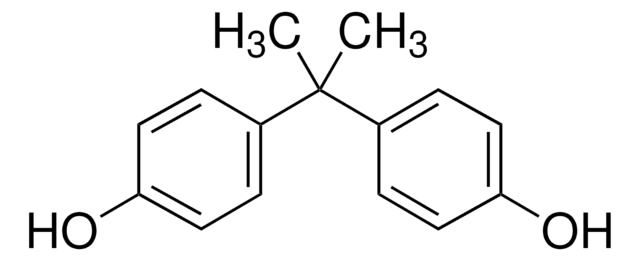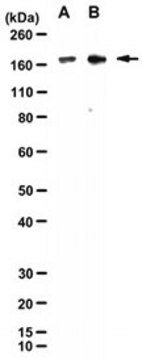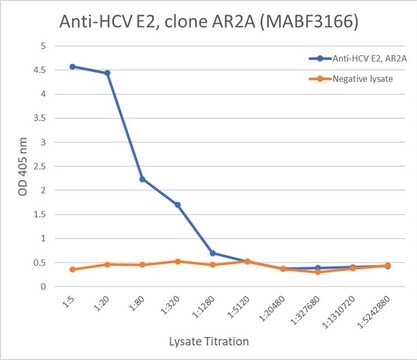MABF2820
Anti-HCV E2 Antibody, clone AP33
Synonim(y):
Glikoproteina E2 otoczki wirusa HCV
About This Item
Polecane produkty
pochodzenie biologiczne
mouse
Poziom jakości
forma przeciwciała
purified antibody
rodzaj przeciwciała
primary antibodies
klon
AP33, monoclonal
masa cząsteczkowa
observed mol wt ~60 kDa
oczyszczone przez
using protein G
reaktywność gatunkowa
virus
opakowanie
antibody small pack of 100 μg
metody
ELISA: suitable
electron microscopy: suitable
immunoprecipitation (IP): suitable
inhibition assay: suitable
neutralization: suitable
western blot: suitable
izotyp
IgG1κ
sekwencja epitopowa
N-terminal half
numer dostępu Protein ID
numer dostępu UniProt
temp. przechowywania
-10 to -25°C
docelowa modyfikacja potranslacyjna
unmodified
informacje o genach
vaccinia virus ... E2(684)
Opis ogólny
Specyficzność
Immunogen
Zastosowanie
Oceniane metodą Western Blotting w lizacie z komórek HEK293T transfekowanych plazmidem wyrażającym glikoproteiny HCV E1 i E2.
Analiza Western Blotting: Rozcieńczenie 1:1000 tego przeciwciała wykryło HCV E2 w lizacie z komórek HEK293T transfekowanych plazmidem wyrażającym glikoproteiny HCV E1 i E2, ale nie w lizatach z nietransfekowanych komórek.
Testowane aplikacje
Inhibicja: Reprezentatywna partia Hamowała interakcję cząstek wirusopodobnych (VLP) z CD81 i hamowała zakażenie HCVpp o różnych genotypach.(Owsianka, A., et al. (2001). J Gen Virol. 82(Pt8):1877-1883; Owsianka, A., et al. (2005). J Virol. 79(17):11095-104).
ELISA: Reprezentatywna partia wykryła HCV E2 w aplikacji ELISA. (Owsianka, A., et al. (2005). J Virol. 79(17):11095-104; Rychłowska, M., et al. (2011). J Gen Virol. 92(Pt10)2249-2261; Vasiliauskaite, I., et al. (2017). mBio. 8(3):e00382-17).
Mikroskopia elektronowa: Reprezentatywna partia wykryła wirusopodobne cząstki HCV w aplikacji kriomikroskopii elektronowej (Owsianka, A., et al. (2001). J Gen Virol. 82(Pt8):1877-1883; Clayton, R.F., et al. (2002). J Virol. 76(15):7672-82).
Analiza Western Blotting: Reprezentatywna partia wykryła HCV E2 w aplikacji Western Blotting (Clayton, R.F., et al. (2002). J Virol. 76(15):7672-82; Rychlowska, M., et al. (2011). J Gen Virol. 92(Pt10)2249-2261; Hu, Z., et al. (2020). Cell Chem Biol. 27(7):780-792.e5).
Analiza immunoprecypitacji: Reprezentatywna partia immunoprecypitowanego HCV E2 w aplikacji immunoprecypitacji (Owsianka, A., et al. (2005). J Virol. 79(17):11095-104).
Neutralizacja: Reprezentatywna partia neutralizowała zakażenie HCV we wszystkich głównych genotypach HCV (Owsianka, A., et al. (2005). J Virol. 79(17):11095-104; Potter, J.A., et al. (2012). J Virol. 86(23):12923-32).
Uwaga: Rzeczywiste optymalne rozcieńczenia robocze muszą być określone przez użytkownika końcowego jako próbki, a warunki eksperymentalne mogą się różnić w zależności od użytkownika końcowego.
Postać fizyczna
Rekonstytucja
Przechowywanie i stabilność
Inne uwagi
Oświadczenie o zrzeczeniu się odpowiedzialności
Nie możesz znaleźć właściwego produktu?
Wypróbuj nasz Narzędzie selektora produktów.
Kod klasy składowania
12 - Non Combustible Liquids
Klasa zagrożenia wodnego (WGK)
WGK 2
Temperatura zapłonu (°F)
Not applicable
Temperatura zapłonu (°C)
Not applicable
Certyfikaty analizy (CoA)
Poszukaj Certyfikaty analizy (CoA), wpisując numer partii/serii produktów. Numery serii i partii można znaleźć na etykiecie produktu po słowach „seria” lub „partia”.
Masz już ten produkt?
Dokumenty związane z niedawno zakupionymi produktami zostały zamieszczone w Bibliotece dokumentów.
Nasz zespół naukowców ma doświadczenie we wszystkich obszarach badań, w tym w naukach przyrodniczych, materiałoznawstwie, syntezie chemicznej, chromatografii, analityce i wielu innych dziedzinach.
Skontaktuj się z zespołem ds. pomocy technicznej








